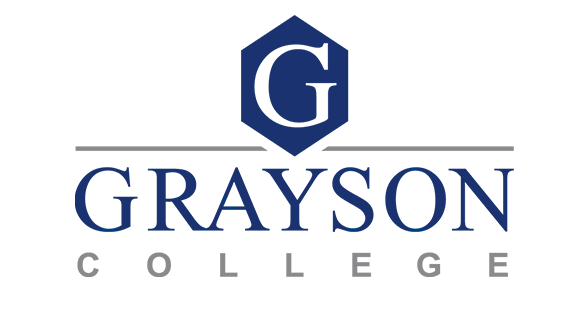Climate Survey Report
Assessment and Strategic Planning Climart Survey Report
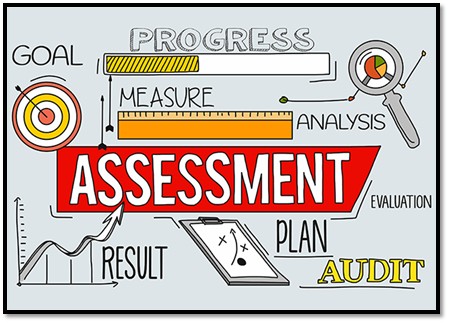
May 28, 2025 through July 1, 2025
Alison Soeder, Director of Strategic Planning and Assessment
July 9, 2025
The data presented in this Survey Report was collected during the Summer 2025 term. The survey was emailed to the Grayson College faculty and staff community on May 28, 2025 using the GCPeople [at] grayson [dot] edu listserv.
Overarching goals for the survey:
- Identify a baseline of understanding and use for assessment and assessment processes at Grayson College
- Identify a baseline of understanding and use for strategic planning and strategic planning processes at Grayson College
- Begin the process of creating a common assessment language and familiarity with feedback/data collection by the office
- Collect qualitative feedback and suggestions from the campus community on assessment needs and challenges
- Identify and collect data from a metric to use year over year to track changes in perception (comfort with, understanding of) of assessment and strategic planning
- On a scale of 0-5, please rate your comfort with and/or understanding of assessment and strategic planning at Grayson College.
There are five distinct elements to the survey: (1) survey overview and demographics (all); (2) strategic plan awareness (all); (3) academic program assessment awareness (PT and FT faculty only); (4) administrative and student support services assessment awareness (staff, executive leadership and all others not faculty only); and the (5) assessment culture and integration.
A total of 125 climate survey responses (32% faculty; 60% staff; 6% other or unknown; and 2% college leadership) were collected.
|
Survey Distribution Length |
Total Responses |
Full Time and Part Time Faculty Respondents |
Staff Respondents |
Other or Not Sure Respondents |
Administration Respondents |
|---|---|---|---|---|---|
| 34 Days | 125 | 40 (32%) | 75 (60%) | 7 (6%) | 3 (2%) |
Results
How familiar are you with our institution's current strategic plan?
| Familiarity Level | Percentage of respondents |
|---|---|
| Very Familiar (I can name specific goals and strategies) | 22.40% |
| Somewhat familiar (I know the general focus | 41.60% |
| Slightly Familiar (I've heard of it but don't know the details) | 27.20% |
| Not at all familiar (I wasn't aware we had a strategic plan) | 8.80% |
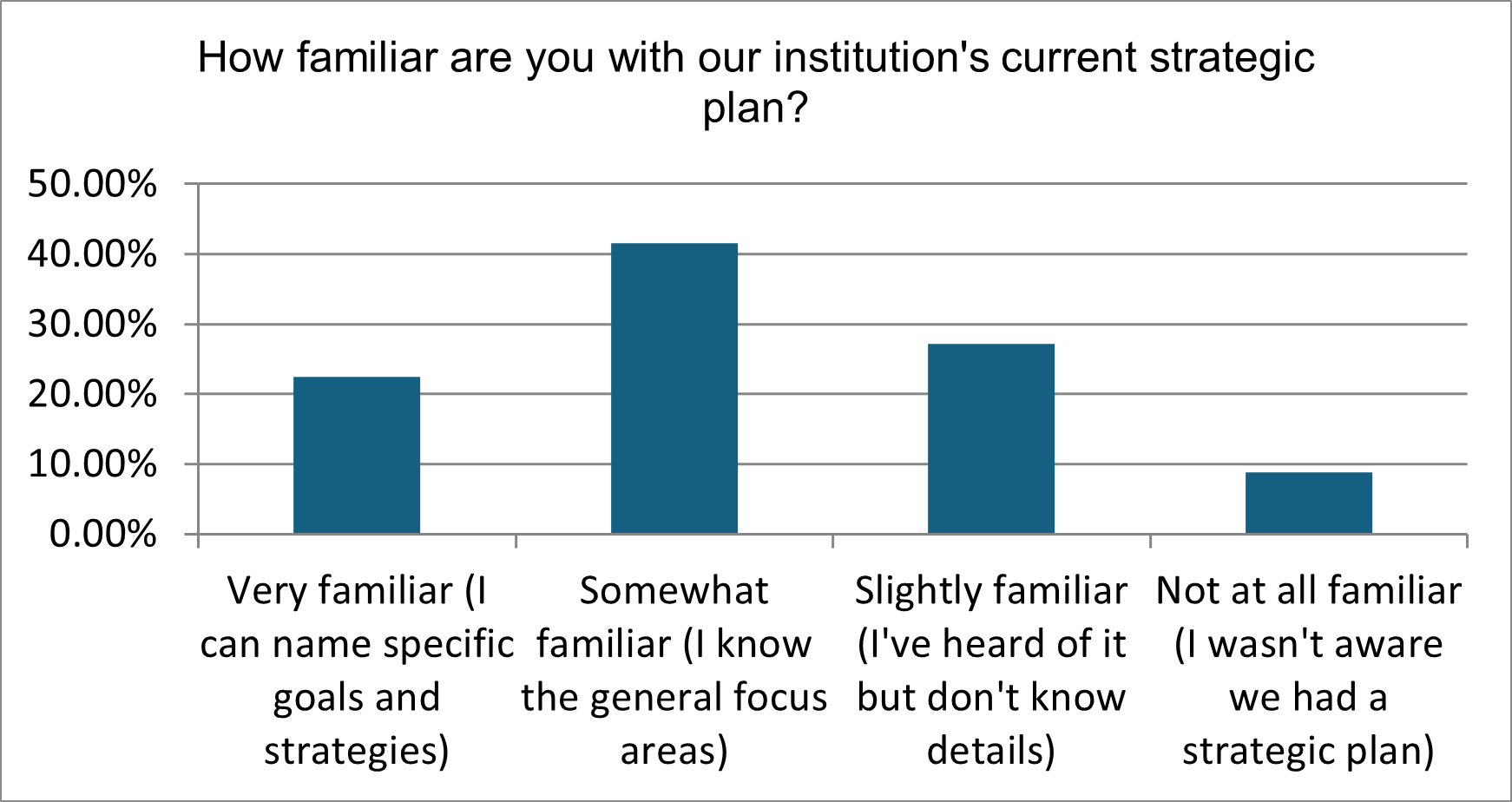
The majority of survey respondents stated that they were somewhat familiar with Grayson College’s Strategic Plan (they felt that they knew the general focus areas), followed by those that felt they had heard of the strategic plan but did not know the details of it. Over 80% of the survey respondents shared that they learned about or of the strategic plan from meetings, either campus-wide or departmental and division meetings (Q3: How did you learn about our strategic plan?). More than 75% of the survey respondents felt that their work directly contributed to the college’s strategic goals a great or moderate extent.
To what extent do you believe your work directly contributes to the college's strategic goals?
| Work Contribution | Precentage of Respondents |
|---|---|
| To a great extent | 52.80% |
| To a moderate extent | 24.80% |
| To a small extent | 6.40% |
| Not at all | 3.20% |
| Unsure | 12.80% |
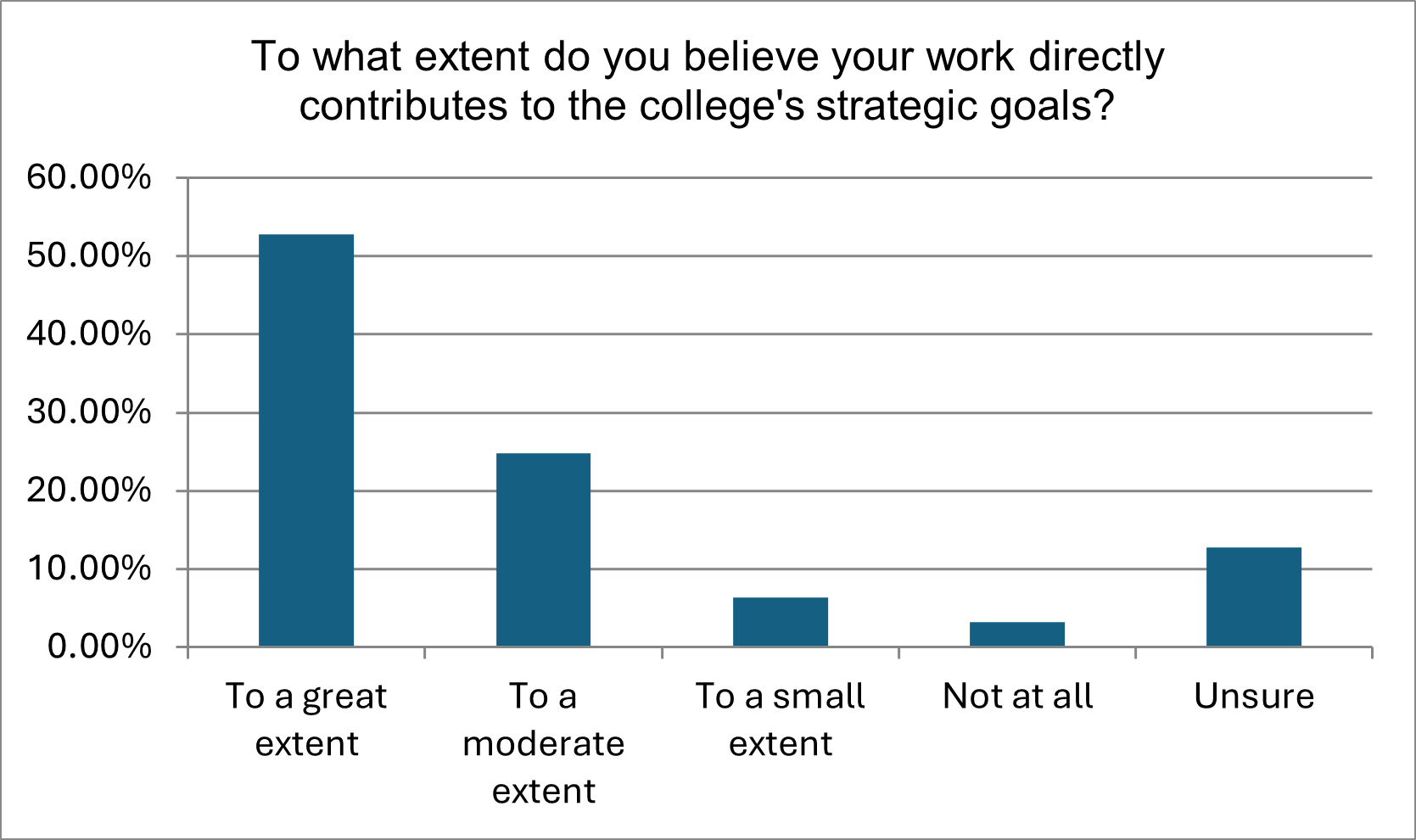
This seems to underscore findings that consistent communication during community meetings not only help faculty and staff learn about the strategic plan, but that, at Grayson College, the majority of faculty and staff who responded to the survey felt a strong working connection to the college’s strategic plan.
Academic Assessment: SACSCOC Principle 8.2.a (Full-Time and Part-Time Faculty)
Faculty felt that they, on average, had a good understanding of academic assessment processes at Grayson College. 19% of respondents felt that they had an expert level understanding of academic assessment, and 73% of respondents identified their understanding as good or basic, with 7% of respondents sharing that their understanding of assessment processes were limited or nonexistent (Q6).
Most faculty survey respondents felt that they often participated in academic assessment activities (collecting student learning data, analyzing assessment results, using assessment results to inform changes, documenting assessment processes, and sharing assessment findings); of these activities, the activity that had the highest engagement level was collecting student learning data followed by analyzing assessment results and then using assessment results to inform changes (weighted average of 3.76, 3.73, and 3.66, respectively).
Faculty also provided feedback on communication, use of time, and perception of assessment activities at Grayson College.
To what extent do you agree with the following statements about academic assessment at our institution?
| Statement | Strongly Agree | Agree | Disagree | Strongly Disagree |
|---|---|---|---|---|
| Assessment processes are clearly communicated | 19.51% | 48.78% | 21.95% | 2.44% |
| I have adequate resources to conduct meaningful assessment | 31.71% | 43.90% | 14.63% | 0% |
| Assessment results are used to improve student learning | 29.27% | 46.34% | 14.63% | 0% |
| Assessment is primarily done to satisfy accreditation requirements | 36.59% | 26.83% | 19.51% | 7.32% |
| Assessment is a valuable use of my time | 24.39% | 46.34% | 14.63% | 0% |
| I receive helpful feedback on my assessment activities | 12.20% | 36.59% | 29.27% | 4.88% |
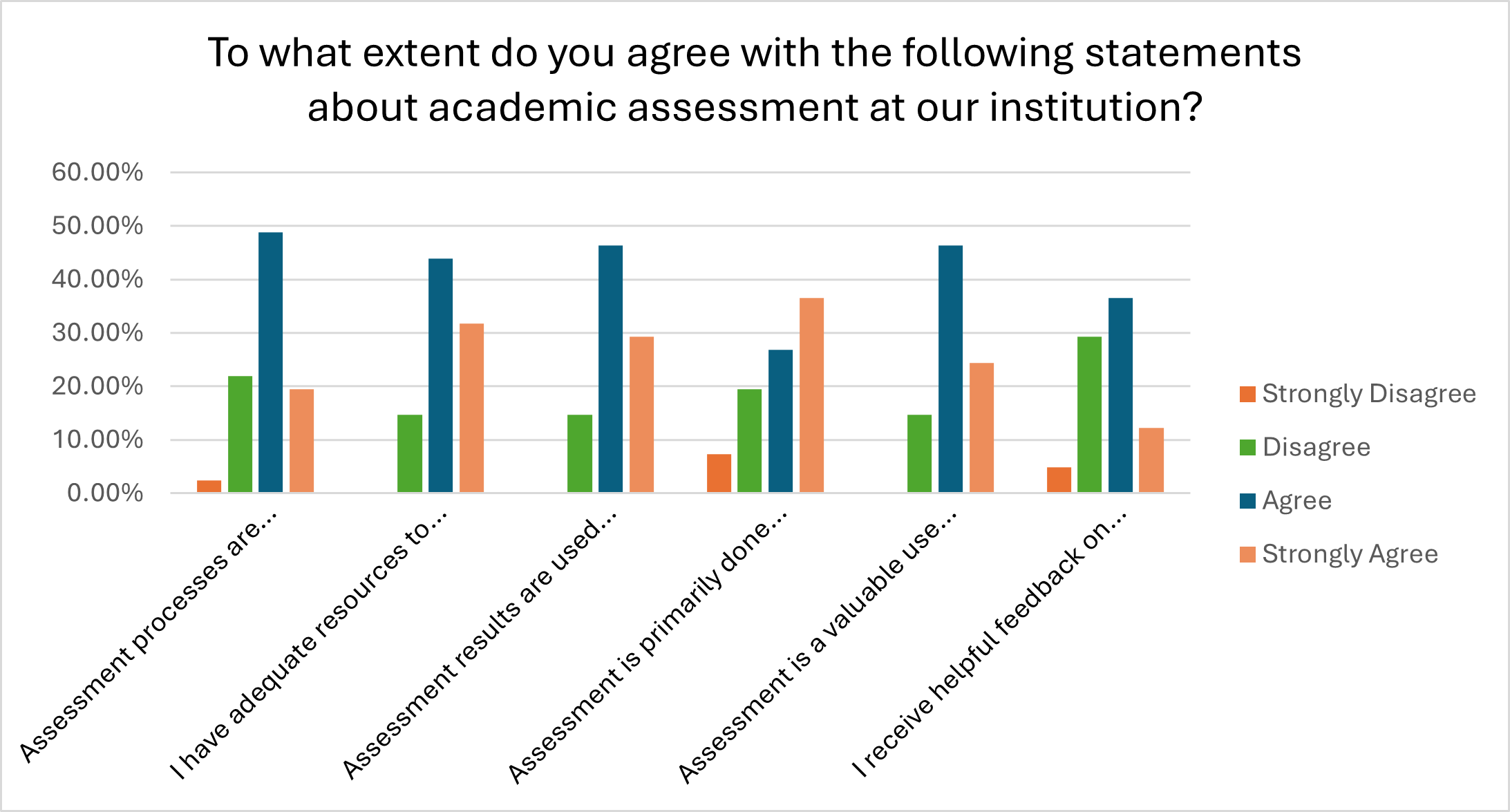
The question was developed as a matrix question, with the statements below, rated on a 4-point scale (Q8).
- Assessment processes are clearly communicated
- I have adequate resources to conduct meaningful assessment
- Assessment results are used to improve student learning
- Assessment is primarily done to satisfy accreditation requirements
- Assessment is a valuable use of my time
- I receive helpful feedback on my assessment activities
The majority of respondents agreed with the statements, with the strongest agreement being with the statement, Assessment is a valuable use of my time, followed by I have adequate resources to conduct meaningful assessment (weighted scores of 3.39 and 3.37).
Faculty identified the primary purposes of academic assessment as
- Improving student learning (70.73%)
- Program improvement (56.10%)
- Meeting accreditation requirements (48.78%)
This seems to align with a desire to improve learning and student achievement outside of accreditation requirements to do so, but with a recognition of accreditation. The two lowest reasons identified by faculty as the primary purpose of assessment were justifying resource allocation and demonstrating institutional effectiveness (21.95% for both). Faculty assessment champions could help support a culture change in regards to perception of assessment and data while maintaining a pedagogical and professional development focus that speaks to faculty needs and restrictions.
Student Support and Administrative Assessment: SACSCOC Principles 7.3 and 8.2.c (Staff, Co llege Executive Leadership, and Note Sure/Other)
Staff and college leadership felt that they, on average, had a basic understanding of non-academic/support assessment processes at Grayson College. 5% of respondents felt that they had an expert level understanding of academic assessment, and 64% of respondents identified their understanding as good, with 31% of respondents sharing that their understanding of assessment processes were limited or nonexistent (Q10).
Most staff and leadership survey respondents felt that they never participated in non-academic/support assessment activities (collecting service or operational data, analyzing assessment results, using assessment results to inform changes, documenting assessment processes, and sharing assessment findings); of these activities, the activity that had the highest engagement level was collecting service or operational data followed by sharing assessment findings with colleagues and then analyzing assessment results (weighted average of 2.45, 2.37, and 2.23, respectively).
Like faculty, staff and college leadership also provided feedback on communication, use of time, and perception of assessment activities at Grayson College.
To what extent do you agree with the following statements about administrative and student support service assessment at Grayson College?
| Statement | Strongly Agree | Agree | Disagree | Strongly Disagree |
|---|---|---|---|---|
| Assessment processes are clearly communicated | 11.48% | 29.51% | 40.98% | 8.20% |
| I have adequate resources to conduct meaningful assessment | 9.84% | 40.98% | 26.23% | 3.28% |
| Assessment results are used to improve services | 20.00% | 51.67% | 13.33% | 1.67% |
| Assessment is primarily done to satisfy accreditation requirements | 16.13% | 45.16% | 25.81% | 1.61% |
| Assessment contributes to overall institutional effectiveness | 25.81% | 51.61% | 8.06% | 1.61% |
| There is transparent reporting of support unit assessment results | 11.48% | 40.98% | 29.51% | 8.20% |
| Support unit assessment leads to tangible improvements for students and staff | 22.95% | 44.26% | 14.75% | 4.92% |
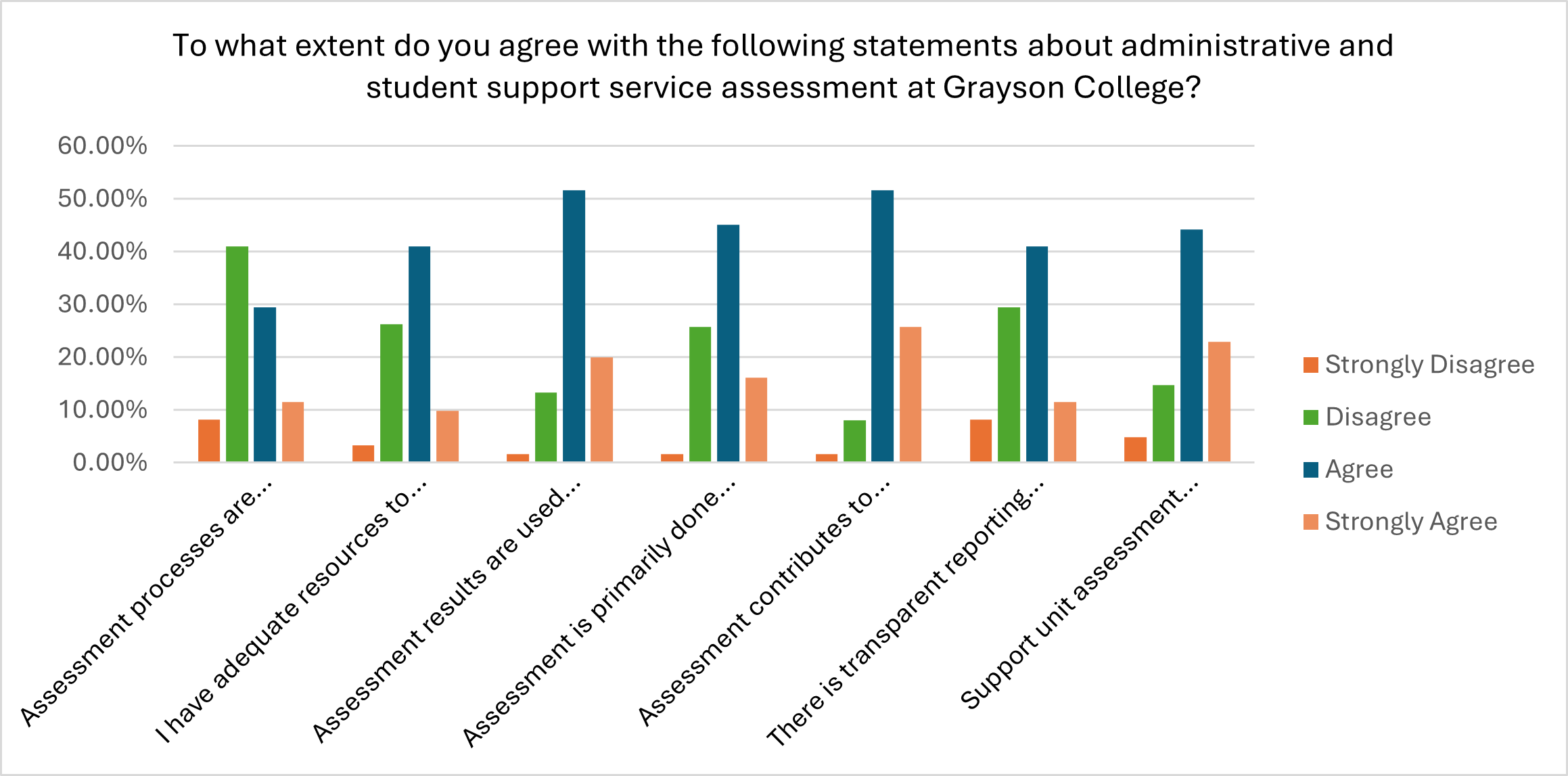
The question was developed as a matrix question, with the statements below, rated on a 4-point scale (Q12).
- Assessment processes are clearly communicated
- I have adequate resources to conduct meaningful assessment
- Assessment results are used to improve services
- Assessment is primarily done to satisfy accreditation requirements
- Assessment contributes to overall institutional effectiveness
- There is transparent reporting of support unit assessment results
- Support unit assessment leads to tangible improvements for students and staff
The majority of respondents agreed with the statements, with the strongest agreement being with the statement, Assessment contributes to overall institutional effectiveness, followed by Assessment results are used to improve services (weighted scores of 3.4 and 3.3).
Staff and college leadership identified the primary purposes of academic assessment as
- Improving services and/or operations (79.03%)
- Meeting accreditation requirements (59.68%)
- Demonstrating institutional effectiveness (48.39%)
These data show that though there is a desire to improve services and operations through assessment work, staff and leadership at Grayson College primarily view assessment processes as being required and rote, without an obvious value add. This could run counter to the lowest rated purpose of assessment, however, which was identified as meeting administrative requirement (20.97%). This speaks to a need for a cultural shift and transformation from compliance driven to improvement minded, with engaging, two-way communication.
Grayson College Assessment Culture and Integration
Faculty and staff, regardless of their work in academic or non-academic assessment, were also asked to provide general feedback on the culture and integration of assessment at Grayson College, primarily focused on perception, barriers, and resources.
| Statement | Strongly Agree | Agree | Disagree | Strongly Disagree |
|---|---|---|---|---|
| Grayson College values assessment as a means for improvement | 12.00% | 64.00% | 16.00% | 1.00% |
| Assessment is integrated into our regular institutional processes | 14.00% | 63.00% | 22.00% | 1.00% |
| Leadership clearly communicates the importance of assessment | 14.00% | 54.00% | 27.00% | 5.00% |
| Assessment results influence decision-making at the institution | 13.13% | 64.65% | 17.17% | 5.05% |
| There is adequate collaboration between departments on assessment | 10.20% | 41.84% | 39.80% | 8.16% |
| I have sufficient opportunities to provide input on assessment processes | 10.10% | 50.51% | 31.31% | 8.08% |
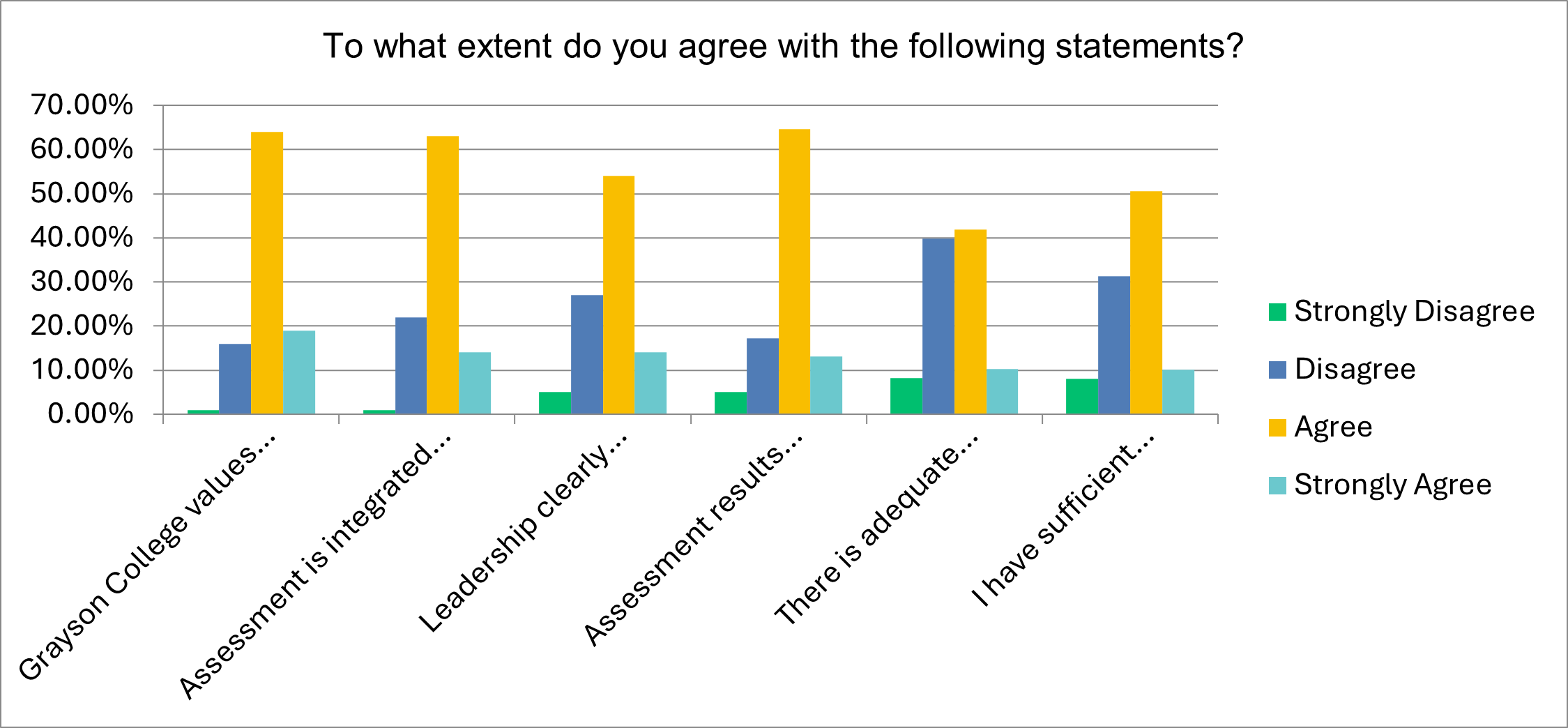
The majority of respondents agreed with the statements below, which primarily focused on perception and engagement:
- Grayson College values assessment as a means for improvement
- Assessment is integrated into our regular institutional processes
- Leadership clearly communicates the importance of assessment
- Assessment results influence decision-making at the institution
- There is adequate collaboration between departments on assessment
- I have sufficient opportunities to provide input on assessment processes
When asked about the frequency of the use of assessment results for different activities, assessment results are often used to make changes to or influence professional development activities and to make changes to classroom assignments or assessments (Q15).
What barriers, if any, prevent you from engaging more fully in assessment activities?
| Statem ent | Percentage of Respondents |
|---|---|
| Lack of Time | 38.78% |
| Insufficient training or knowledge | 39.80% |
| Unclear expectations or procedures | 38.78% |
| Lack of leadership support | 10.20% |
| Insufficient Resources | 8.16% |
| Skepticism about the value of assessment | 19.39% |
| Concerns about how results will be used | 15.31% |
| Other | 28.57% |
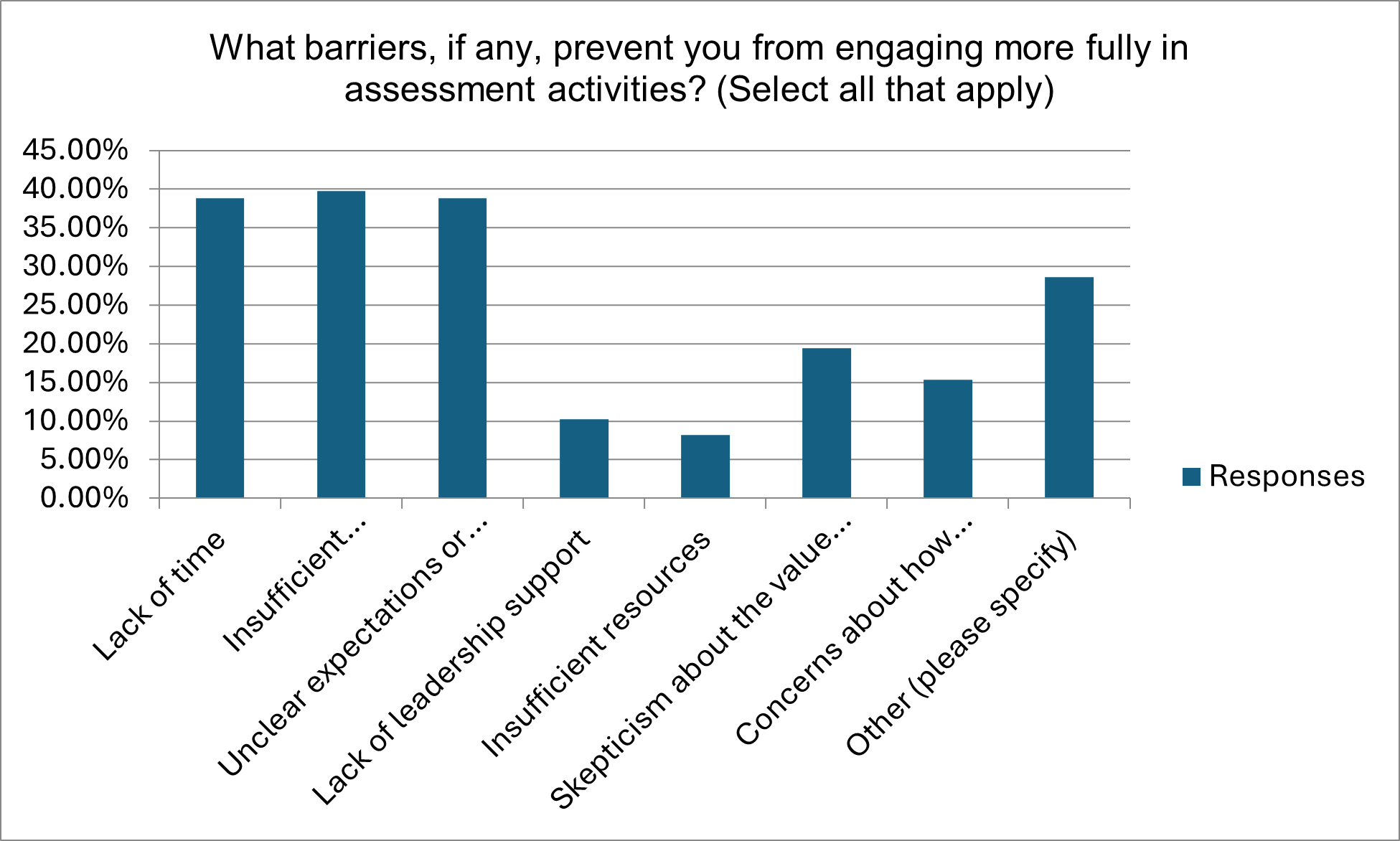
When asked about barriers that prevented survey respondents from engaging more fully in assessment activities, the top three barriers identified were (Q16 and 17):
- Insufficient training/knowledge
- Lack of time
- Unclear expectations or procedures
These speak to the need for clearer and more consistent communication from the Office of Planning and Institutional Effectiveness as well as the creation and offering of training and professional development, as well as readily available, applicable, and relevant assessment resources and information. The top identified resources or support needed by faculty and staff were clear guidelines and examples and additional training/workshops (63.27% and 52.04%).
Additionally, as the value of assessment and continuous improvement work is communicated and embedded in the college, hopefully additional time will be provided to those who are engaged in assessment and serve as PIE Authors to complete their assessment work, but to also have discussions and meetings with colleagues and peers on assessment findings and opportunities for improvement.
The final question before the free-response feedback items is a question developed with the intention for it to be used for all, if not most, of the Planning and Institutional Effectiveness feedback surveys. The question asks, On a scale of 0-5, please rate your comfort with and/or understanding of assessment and strategic planning at Grayson College. It is the goal to see this number increase over time, based on the work and support provided by the PIE Office.
The average response from survey respondents in Summer 2025 was 2.6.
Generalized Findings
- The campus community is somewhat familiar with the Grayson College strategic plan, and learned about it in meetings, either at the college or department level.
- The campus community feels that their work directly contributes, to a great extent, to the Grayson College strategic plan.
- Faculty and staff reported different levels of understanding in their respective assessment areas, with 92% of faculty rating their academic assessment knowledge as good to expert compared to 69% of staff and leadership rating their non-academic assessment knowledge similarly.
- Faculty and staff primarily spend assessment time on collecting data; faculty then feel they share the data and make changes, while staff share the data and then analyze results.
- Faculty and staff agree that the primary purpose of assessment is improvement of student learning and services. Staff seem to more strongly identify assessment as something that must be done for accreditation and institutional purposes than do faculty, though both highly acknowledge the role of accreditation in assessment.
- Faculty participate in assessment at higher self-reported rates than do staff, who largely reported that they never participated in assessment reporting or work.
- Faculty and staff generally seem to perceive and participate in assessment well and willingly, though engagement is hindered by barriers that include time and process knowledge.
- The free response questions identify knowledge and awareness gaps and communication challenges as improvements needed for assessment processes, in addition to better technology integration.
- Faculty and staff feel that a cultural shift is needed; that assessment is currently a “box to check” and that there is a desire to more meaningfully engage with assessment and assessment data.
- Faculty and staff have identified a desire for leadership and follow-through in the areas of assessment and institutional effectiveness, with an emphasis on visible action and recommendation communication.
Appendices
Appendix A: Free Response Questions and Appendix B: Survey Email Communications are available upon request.
